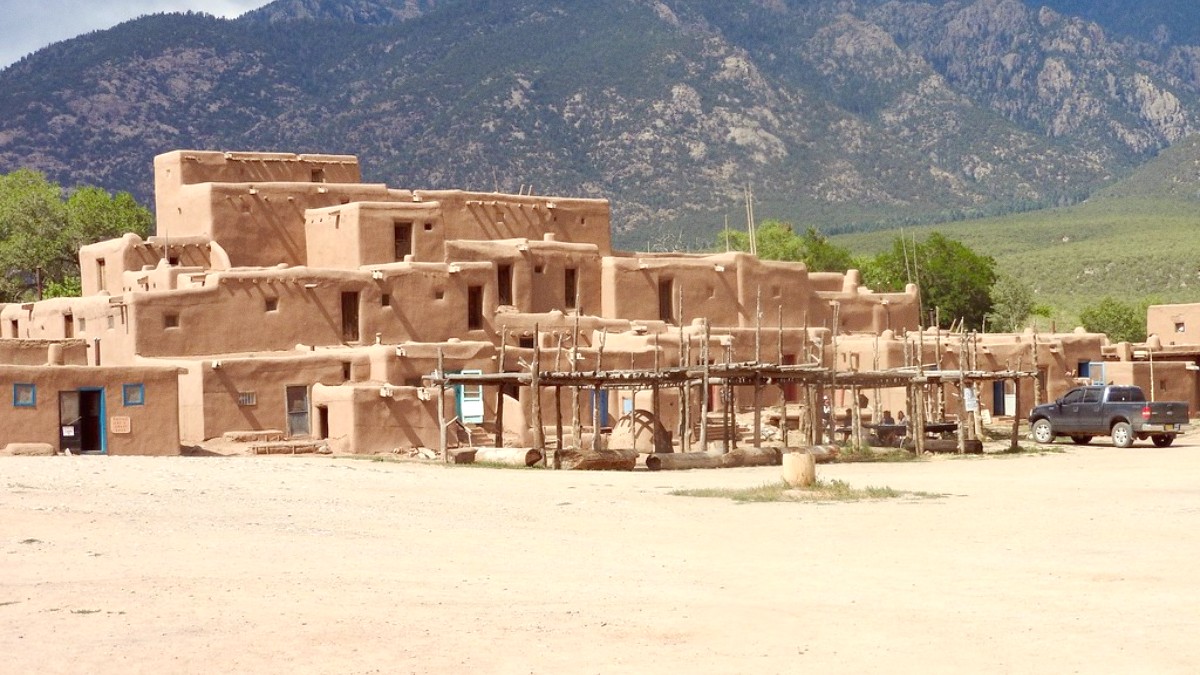
New Mexico, USA
Each season offers a different experience. Temperatures fluctuate widely between day and night, making layering a good approach.
The high altitude of 7,000 feet means acclimatization and hydration are important. Monsoons can occur in summer.
Consider specific activities for optimal timing:
Cultural Visits (Taos Pueblo): Visit year-round. Always check Taospueblo.com for unexpected closures due to religious ceremonies or weather. Winter offers a unique, quiet beauty.
Hiking/Outdoor Activities: Spring and Fall offer comfortable temperatures and fewer monsoons. Summer mornings are good for activity before the heat and storms arrive.
Skiing/Snowboarding: Visit from December to March to enjoy the nearby Taos Ski Valley.
Photography: Early mornings or late afternoons provide the best light. Be aware of strict photography rules at the Pueblo.
(June-August, Mid-Sept to Mid-Oct)
Warm weather for outdoors, many cultural events, beautiful fall foliage.
Larger crowds, higher accommodation prices, afternoon monsoon showers.
(April-May, November)
Fewer crowds, pleasant temperatures (especially May), lower accommodation prices, good for hiking.
Variable weather, some attractions with reduced hours, November can be cold.
(December-March, excluding holidays)
Fewest crowds, beautiful snow-covered landscape, lower prices, unique winter Taos Pueblo visit.
Cold temperatures, snowstorms can disrupt travel, some roads inaccessible, Pueblo closes more frequently for holidays.
From July through September, expect daily afternoon thunderstorms. These often last briefly but can be intense. Roads may become slick. Flash flooding is possible in low-lying areas, though less common at the Pueblo itself. Remain aware of weather changes during these months.
Summer daytime temperatures can exceed 90°F (32°C). Winter nights can drop below 0°F (-18°C). Layering clothes is a recommendation to handle these swings.
Acclimate slowly upon arrival.
Drink plenty of water.
Avoid alcohol and heavy exercise for the first 24-48 hours.
Symptoms like headache, nausea, dizziness, shortness of breath are possible.
Take frequent breaks if active.
Travelers heading to Taos Pueblo, especially international visitors, should understand US entry rules. These rules apply regardless of arrival method: air, land, or sea.
US Citizens: No visa for domestic travel. Canadian Citizens: Generally no visa for tourism/business up to 6 months. Valid passport needed. Visa Waiver Program (VWP) Countries: Citizens (most EU, Australia, Japan, South Korea, UK) apply for Electronic System for Travel Authorization (ESTA) online. Up to 90 days for tourism/business. Approved ESTA before departure. Apply via IVisa or VisaHQ.
Non-VWP Countries: B-2 (tourist) visa needed. Application involves completing Form DS-160 online, fee payment, interview at US embassy/consulate, and supporting documents. Plan well in advance.
As of late 2023 and early 2024, general admission for Taos Pueblo is $20 per person. Children aged 10 and under enter free. Group rates vary. Check Taospueblo.com for current rates.
This permit is required, purchased at the Taos Pueblo visitor center. Additional fees: $25 for cameras, $35 for video cameras (as of late 2023). Strict rules apply to use. Respect all posted signs and instructions from Pueblo guides. Failing to do so can result in equipment confiscation or removal.
A tribal fishing permit and a New Mexico state fishing license are needed for fishing on Pueblo land.
For international travelers, standard US Customs and Border Protection (CBP) procedures apply at your first port of entry in the US, not at Taos Pueblo.
The United States has no specific health-related entry requirements for international travelers beyond general health declarations.
Proof of specific vaccinations for entry is not needed.
You might need to show proof of enough money to cover trip expenses.
Plan your budget before a Taos Pueblo visit. Costs vary by travel style.
The currency is the United States Dollar (USD). ATMs are widely available in Taos town (banks, grocery stores, convenience stores).
Costs vary based on accommodation, meal preferences, and activities.
These figures are per person and vary with personal choices.
Your well-being during your visit to Taos Pueblo and the surrounding area matters. Be mindful of health considerations and safety guidelines.
Taos Pueblo sits at 7,000 feet. Symptoms include headache, nausea, dizziness, and shortness of breath. The high altitude and dry climate lead to rapid dehydration.
Acclimatize slowly. Stay hydrated by drinking plenty of water. Avoid alcohol and heavy exercise for the first 24-48 hours after arrival. Take frequent breaks. Carry a Hydro Flask Water Bottle or similar reusable bottle and drink frequently, even if not thirsty.
Dial 911 for all emergencies: police, fire, and ambulance services. Holy Cross Medical Center (575) 758-8883 is the main hospital in Taos, offering comprehensive emergency services.
Urgent care clinics are available for non-emergency medical needs.
Pharmacies like Walgreens and CVS are in Taos for prescriptions and OTC medications.
Taos is generally a safe town for tourists. Violent crime rates are below the national average. Property crime rates can be higher than average.
Exercise normal precautions: secure valuables, lock car doors.
Avoid walking alone in poorly lit areas at night. Petty theft is rare but possible anywhere.
Travel insurance is highly recommended for all travelers, especially international visitors. It helps cover unexpected events including medical emergencies, trip cancellation or interruption, and luggage loss.
Compare policies from providers like World Nomads or SafetyWing.
Ensure coverage for your specific activities and potential unforeseen circumstances.
| Risk | Description | Mitigation |
|---|---|---|
| Wildfires | Risk during dry summer months. | Check local news and forest alerts before hiking. |
| Winter Storms | Heavy snowfall can close roads and disrupt travel. | Monitor weather forecasts and road conditions. |
| Flash Flooding | Possible during summer monsoon season, especially in arroyos. | Do not drive through flooded roads; stay aware of rapidly rising water. |